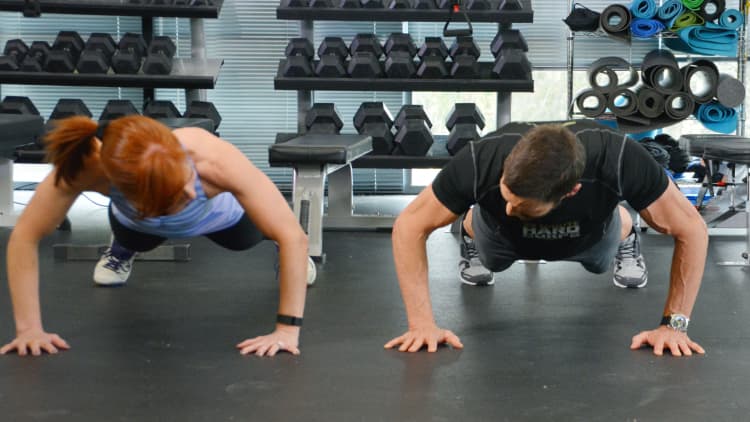
Want to intensify your workout in the new year?
Try chilling your muscles in a cryotherapy chamber. If that's not your cup of tea, strap some electric stimulators onto your biceps while you're pumping iron.
These are just some of the latest, highest-priced fitness fads, yet the workouts seeing the most growth are actually some of the oldest around.
For aerobics, cross training grew by 14 percent, according to the latest survey by the Sports and Fitness Industry Association. High intensity interval training, was also up 10 percent, and regular old stair climbing saw 9 percent growth. The association's survey looked at fitness habits of Americans who said they work out at least 50 times per year.
If anything is new, it's water. Aquatic resistance workouts are growing in popularity, probably due to the aging population of active baby boomers. Water is easier on the joints. And on the other end, treadmills are seeing a rebirth among millennials.
Overall, the fitness industry has been growing at a million new club memberships a year since 2012, according to SIFA. These run from discount clubs with memberships as low as $9.99 a month to high-end boutique studio sessions commanding over $50 for 45 minutes. And the industry could get even bigger this year.
More options
"What we see is the millennial customer in particular just wants to see different kinds of options, so they may join one or two," said Tom Cove, president and CEO of SIFA, adding that the stronger economy may benefit the higher-priced boutique category.
Boutique fitness is expanding aggressively to more markets, with names like Barry's Bootcamp and Solidcore opening new studios across the country. Some brands are tailoring their pricing to draw even more consumers in smaller cities with lower median incomes. Companies like ClassPass, which offer bulk discounts to specific studios, are also seeing growth.
The challenge, however, will be in the offerings. Bootcamp-style workouts actually saw a 6 percent drop in growth in the survey. That could be a warning sign to Barry's, which opened six new locations in 2017.
Barry's CEO, Joey Gonzalez, in an interview last summer, emphasized that the brand was as important as the workout in an increasingly competitive space.
"The world just started to change and the landscape got really crowded. A lot of copy cats, people trying to do exactly what Barry's does, which encouraged us to move a little bit faster," said Gonzalez.
Being adaptable
Fitness brands are going beyond just the workout in order to sell the product.
"We have a full selection of incredible apparel that changes every four to six weeks…the amenities, the locker room and showers. We're trying to give people an experience they can't get anywhere else," said Gonzalez.
"Barry's has always differentiated itself through the actual workout because of its efficacy and that's how we really gained popularity but now we're turning it up a notch and making it the most premium experience," he said.
A premium experience is one tactic, adaptability is another.
Multiple and ever-changing offerings are fueling big chain names like Crunch, and Anytime Fitness. In the past, big gyms used to just warehouse equipment. Now classes in the facilities are as big a draw, if not bigger, and the variety builds on the desire for cross training.
Fitness is really simple.David CarranzaD.C. Crunch
"The companies, both those that make equipment and provide services, that are adaptable and flexible and, most importantly, understand their consumers, are the ones that are going to succeed," said Cove.
"If what worked five years ago is the plan for the next five years, you can guarantee that's not going to work. It's as simple as that," he said.
In the early morning hours on a frigid Tuesday, New Year's resolutions and sweat were flying in equal amounts at a Crunch in Washington, D.C. Treadmills, ellipticals and stair-climbers were all whirring at a brisk pace, yet a lot of patrons were using no equipment at all. Simple body weight training is seeing the biggest growth of all, up 20 percent. Push-ups, pull-ups and squats.
"I think it's going back to basics, what used to work back in the day which is just bodyweight exercises," said David Carranza, general manager at the D.C. Crunch. "I think people were just overthinking it. Fitness is really simple."
Changing preferences
Of course, even the basics can benefit certain companies. A band used for bodyweight training and stretching, known as TRX, is one of the hottest accessories around, as kettlebell popularity starts to wane. Pilates and yoga are also gaining strength.
High-intensity training may have seen the biggest growth last year, but the pendulum is already swinging. One of the big gainers in 2018 could be low-intensity training, combined with an explosion in mindfulness.
"The whole idea of maybe taking a little bit longer, maybe taking some time to meld exercise and meditation and yoga and all that," said Cove.
"It's not as if it's a new thing, but it might be, and we're looking at mindfulness matched with low intensity. It might be a balance to what is clearly a trend with high intensity."


